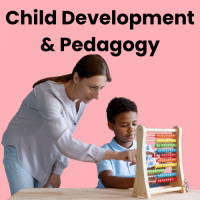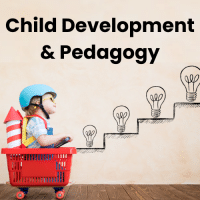Teaching Exam > Teaching Questions > Child-centered pedagogy isa)to teach children...
Start Learning for Free
Child-centered pedagogy is
- a)to teach children in small child care centers to ensure individual attention
- b)teaching as per the desire of a child
- c)teacher explains the concept by standing in the center with children encircling her
- d)giving the primary approach to children's experiences and their active participation
Correct answer is option 'D'. Can you explain this answer?
Most Upvoted Answer
Child-centered pedagogy isa)to teach children in small child care cent...
Child-centered pedagogy is an approach to teaching that places the primary focus on the experiences and active participation of the child. It is based on the belief that children learn best when they are actively engaged in the learning process, and when the learning is relevant to their lives and interests.
Benefits of Child-Centered Pedagogy:
1. Encourages Active Learning: Child-centered pedagogy encourages children to take an active role in their learning. This approach recognizes that children are naturally curious and eager to learn, and that they learn best when they are engaged in hands-on, experiential learning activities.
2. Builds Confidence and Self-Esteem: By giving children the opportunity to take an active role in their learning, child-centered pedagogy helps to build their confidence and self-esteem. When children feel that their ideas and experiences are valued, they are more likely to feel confident in their abilities and more motivated to learn.
3. Promotes Critical Thinking: Child-centered pedagogy encourages children to think critically and creatively about the world around them. By asking open-ended questions and encouraging children to explore and discover the answers for themselves, this approach helps children to develop their analytical and problem-solving skills.
4. Fosters a Love of Learning: When children are actively engaged in their learning and when the learning is relevant to their lives and interests, they are more likely to develop a love of learning that will stay with them throughout their lives.
Conclusion:
In conclusion, child-centered pedagogy is an effective approach to teaching that places the primary focus on the experiences and active participation of the child. By encouraging active learning, building confidence and self-esteem, promoting critical thinking, and fostering a love of learning, this approach helps to ensure that children are prepared for success both in and out of the classroom.
Benefits of Child-Centered Pedagogy:
1. Encourages Active Learning: Child-centered pedagogy encourages children to take an active role in their learning. This approach recognizes that children are naturally curious and eager to learn, and that they learn best when they are engaged in hands-on, experiential learning activities.
2. Builds Confidence and Self-Esteem: By giving children the opportunity to take an active role in their learning, child-centered pedagogy helps to build their confidence and self-esteem. When children feel that their ideas and experiences are valued, they are more likely to feel confident in their abilities and more motivated to learn.
3. Promotes Critical Thinking: Child-centered pedagogy encourages children to think critically and creatively about the world around them. By asking open-ended questions and encouraging children to explore and discover the answers for themselves, this approach helps children to develop their analytical and problem-solving skills.
4. Fosters a Love of Learning: When children are actively engaged in their learning and when the learning is relevant to their lives and interests, they are more likely to develop a love of learning that will stay with them throughout their lives.
Conclusion:
In conclusion, child-centered pedagogy is an effective approach to teaching that places the primary focus on the experiences and active participation of the child. By encouraging active learning, building confidence and self-esteem, promoting critical thinking, and fostering a love of learning, this approach helps to ensure that children are prepared for success both in and out of the classroom.

|
Explore Courses for Teaching exam
|

|
Question Description
Child-centered pedagogy isa)to teach children in small child care centers to ensure individual attentionb)teaching as per the desire of a childc)teacher explains the concept by standing in the center with children encircling herd)giving the primary approach to childrens experiences and their active participationCorrect answer is option 'D'. Can you explain this answer? for Teaching 2025 is part of Teaching preparation. The Question and answers have been prepared according to the Teaching exam syllabus. Information about Child-centered pedagogy isa)to teach children in small child care centers to ensure individual attentionb)teaching as per the desire of a childc)teacher explains the concept by standing in the center with children encircling herd)giving the primary approach to childrens experiences and their active participationCorrect answer is option 'D'. Can you explain this answer? covers all topics & solutions for Teaching 2025 Exam. Find important definitions, questions, meanings, examples, exercises and tests below for Child-centered pedagogy isa)to teach children in small child care centers to ensure individual attentionb)teaching as per the desire of a childc)teacher explains the concept by standing in the center with children encircling herd)giving the primary approach to childrens experiences and their active participationCorrect answer is option 'D'. Can you explain this answer?.
Child-centered pedagogy isa)to teach children in small child care centers to ensure individual attentionb)teaching as per the desire of a childc)teacher explains the concept by standing in the center with children encircling herd)giving the primary approach to childrens experiences and their active participationCorrect answer is option 'D'. Can you explain this answer? for Teaching 2025 is part of Teaching preparation. The Question and answers have been prepared according to the Teaching exam syllabus. Information about Child-centered pedagogy isa)to teach children in small child care centers to ensure individual attentionb)teaching as per the desire of a childc)teacher explains the concept by standing in the center with children encircling herd)giving the primary approach to childrens experiences and their active participationCorrect answer is option 'D'. Can you explain this answer? covers all topics & solutions for Teaching 2025 Exam. Find important definitions, questions, meanings, examples, exercises and tests below for Child-centered pedagogy isa)to teach children in small child care centers to ensure individual attentionb)teaching as per the desire of a childc)teacher explains the concept by standing in the center with children encircling herd)giving the primary approach to childrens experiences and their active participationCorrect answer is option 'D'. Can you explain this answer?.
Solutions for Child-centered pedagogy isa)to teach children in small child care centers to ensure individual attentionb)teaching as per the desire of a childc)teacher explains the concept by standing in the center with children encircling herd)giving the primary approach to childrens experiences and their active participationCorrect answer is option 'D'. Can you explain this answer? in English & in Hindi are available as part of our courses for Teaching.
Download more important topics, notes, lectures and mock test series for Teaching Exam by signing up for free.
Here you can find the meaning of Child-centered pedagogy isa)to teach children in small child care centers to ensure individual attentionb)teaching as per the desire of a childc)teacher explains the concept by standing in the center with children encircling herd)giving the primary approach to childrens experiences and their active participationCorrect answer is option 'D'. Can you explain this answer? defined & explained in the simplest way possible. Besides giving the explanation of
Child-centered pedagogy isa)to teach children in small child care centers to ensure individual attentionb)teaching as per the desire of a childc)teacher explains the concept by standing in the center with children encircling herd)giving the primary approach to childrens experiences and their active participationCorrect answer is option 'D'. Can you explain this answer?, a detailed solution for Child-centered pedagogy isa)to teach children in small child care centers to ensure individual attentionb)teaching as per the desire of a childc)teacher explains the concept by standing in the center with children encircling herd)giving the primary approach to childrens experiences and their active participationCorrect answer is option 'D'. Can you explain this answer? has been provided alongside types of Child-centered pedagogy isa)to teach children in small child care centers to ensure individual attentionb)teaching as per the desire of a childc)teacher explains the concept by standing in the center with children encircling herd)giving the primary approach to childrens experiences and their active participationCorrect answer is option 'D'. Can you explain this answer? theory, EduRev gives you an
ample number of questions to practice Child-centered pedagogy isa)to teach children in small child care centers to ensure individual attentionb)teaching as per the desire of a childc)teacher explains the concept by standing in the center with children encircling herd)giving the primary approach to childrens experiences and their active participationCorrect answer is option 'D'. Can you explain this answer? tests, examples and also practice Teaching tests.

|
Explore Courses for Teaching exam
|

|
Signup for Free!
Signup to see your scores go up within 7 days! Learn & Practice with 1000+ FREE Notes, Videos & Tests.


















